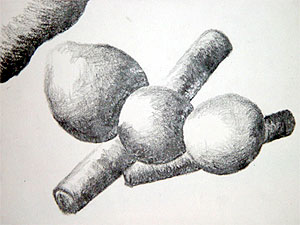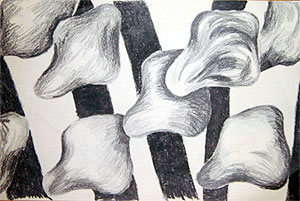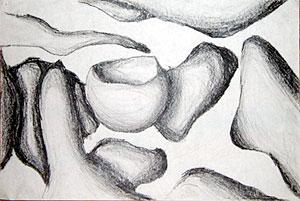Fifth Grade Art Lesson 4
Value Study, Making Organic Shapes Into Forms
Objective:
The students will learn that value reveals form. The students will indicate their understanding of value by making shapes into forms using value.
Materials:
9 x 12 inch white paper, a 1 x 6 inch strip of white paper, black crayons
Procedure:
Value is an element of art that helps us to create three-dimensional forms. Who knows the difference between a shape and a form? A shape is two-dimensional; it only has height and width. But a form has height, width, and depth; three measurements for a three-dimensional object. We are going to first create a gray scale. Take the small strip of paper and at the very top color in a small square as dark as you can possibly bear down without breaking your crayon. Just beneath this square color in a second square that is also very dark, but not quite as dark as the previous one. Continue this process until you get to the bottom of your strip which you will leave white, gradually lightening up as you go down, until you are whispering your crayon across the paper. Hang onto your gray scale as we will use it throughout this year, and particularly today. Take your white sheet of paper and lightly draw off three or four organic shapes. Using your gray scale you're going to shade in around the edges of your shapes until you've created the illusion of form. Be sure that you blend in the outlines with value or shading to keep your form from looking flat which is what outlines do. As you color curve your strokes as though you were going around the form. This is not difficult to do, but takes time. Do not get in a hurry. Finish well.
Conclusion:
Ask the students to tell what value is, what a gray scale is, and to find examples of value in the room.
Artwork and Examples used in this lesson

Teachers Organic Form Example

Teachers Organic Form Example

Student Artwork













